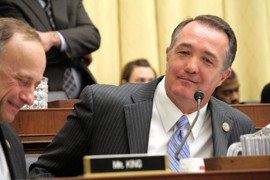Cronkite News has moved to a new home at cronkitenews.azpbs.org. Use this site to search archives from 2011 to May 2015. You can search the new site for current stories.
Franks calls electric grid “completely vulnerable,” urges new protections
WASHINGTON – He concedes that the worst-case scenario is a once-in-100-years event, but Rep. Trent Franks, R-Glendale, said the U.S. still needs to defend against an electromagnetic pulse attack or solar storm that could cripple the nation.
Franks, who has sponsored a bill calling for tougher regulation of electronic systems, testified Wednesday at a House Homeland Security subcommittee hearing on the risk of an electromagnetic pulse, or EMP, attack.
An EMP is a shock wave that can disrupt magnetic fields, generate large ground currents and potentially damage bulk-power electric systems. EMP events can occur naturally during solar storms, though the threat of an EMP in weapon form has received increased attention.
Rep. Dan Lungren, R-Calif., called an EMP event a “serious threat.”
“The national electric grid has almost no backup capability in the event of a power collapse from electromagnetic pulses,” said Lungren, chairman of the Homeland Security Subcommittee on Cybersecurity, Infrastructure Protection and Security Technologies.
He said in his opening statement that “existing bulk-power reliability standards don’t even address EMP vulnerabilities.”
Franks said the military hardened its systems against EMP events, but the civilian grid has not seen the same investment and is “almost completely unprepared.”
“I’m the last one that wants to regulate any industry, but I’m the first one who wants to protect national security,” Franks said. “I would suggest that the potential liability here is off the charts.”
Other panelists also emphasized the contrast between the defense sector’s preparation and the unpreparedness of the civilian grid.
But many of the vulnerable industries – namely telecommunications and energy suppliers – rely on infrastructure that would face increased scrutiny and expenses under new regulations.
Joseph McClelland, director of the Office of Electric Reliability for the Federal Energy Regulatory Commission, estimated the cost of hardening electric grids against geomagnetic disturbances at $500,000 per transformer.
But Franks said something must be done. He introduced the Secure High-voltage Infrastructure for Electricity from Lethal Damage Act – the SHIELD Act – in early 2011 but the bill has yet to be scheduled for a hearing. Similar proposals have failed in recent Congresses.
In testimony prepared for the hearing, Franks acknowledged the “crushing dilemma on industry” when faced with a decision to either shut down operations as a preventative measure or to risk damage to its systems.
“The fix here is fairly simple at least in terms of protecting our electric-producing grid,” Franks said. “Not all of the elements that are connected to it – that’s a huge issue – but at least to be able to keep the lights on and the electricity coming, that’s a fairly easy fix.”







